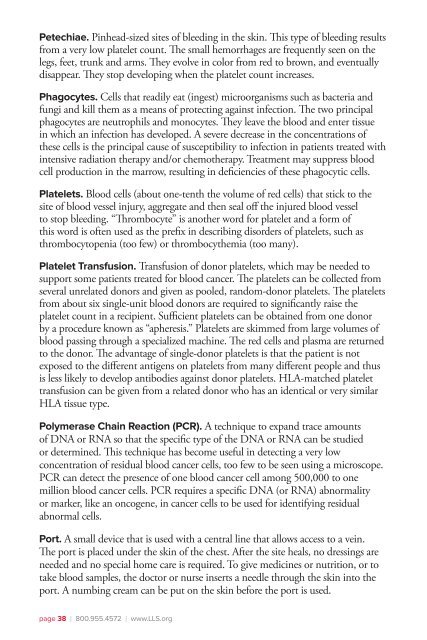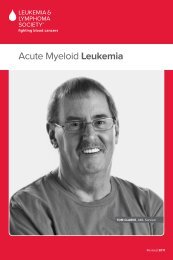Chronic Lymphocytic Leukemia - The Leukemia & Lymphoma Society
Chronic Lymphocytic Leukemia - The Leukemia & Lymphoma Society
Chronic Lymphocytic Leukemia - The Leukemia & Lymphoma Society
You also want an ePaper? Increase the reach of your titles
YUMPU automatically turns print PDFs into web optimized ePapers that Google loves.
Petechiae. Pinhead-sized sites of bleeding in the skin. This type of bleeding results<br />
from a very low platelet count. <strong>The</strong> small hemorrhages are frequently seen on the<br />
legs, feet, trunk and arms. <strong>The</strong>y evolve in color from red to brown, and eventually<br />
disappear. <strong>The</strong>y stop developing when the platelet count increases.<br />
Phagocytes. Cells that readily eat (ingest) microorganisms such as bacteria and<br />
fungi and kill them as a means of protecting against infection. <strong>The</strong> two principal<br />
phagocytes are neutrophils and monocytes. <strong>The</strong>y leave the blood and enter tissue<br />
in which an infection has developed. A severe decrease in the concentrations of<br />
these cells is the principal cause of susceptibility to infection in patients treated with<br />
intensive radiation therapy and/or chemotherapy. Treatment may suppress blood<br />
cell production in the marrow, resulting in deficiencies of these phagocytic cells.<br />
Platelets. Blood cells (about one-tenth the volume of red cells) that stick to the<br />
site of blood vessel injury, aggregate and then seal off the injured blood vessel<br />
to stop bleeding. “Thrombocyte” is another word for platelet and a form of<br />
this word is often used as the prefix in describing disorders of platelets, such as<br />
thrombocytopenia (too few) or thrombocythemia (too many).<br />
Platelet Transfusion. Transfusion of donor platelets, which may be needed to<br />
support some patients treated for blood cancer. <strong>The</strong> platelets can be collected from<br />
several unrelated donors and given as pooled, random-donor platelets. <strong>The</strong> platelets<br />
from about six single-unit blood donors are required to significantly raise the<br />
platelet count in a recipient. Sufficient platelets can be obtained from one donor<br />
by a procedure known as “apheresis.” Platelets are skimmed from large volumes of<br />
blood passing through a specialized machine. <strong>The</strong> red cells and plasma are returned<br />
to the donor. <strong>The</strong> advantage of single-donor platelets is that the patient is not<br />
exposed to the different antigens on platelets from many different people and thus<br />
is less likely to develop antibodies against donor platelets. HLA-matched platelet<br />
transfusion can be given from a related donor who has an identical or very similar<br />
HLA tissue type.<br />
Polymerase Chain Reaction (PCR). A technique to expand trace amounts<br />
of DNA or RNA so that the specific type of the DNA or RNA can be studied<br />
or determined. This technique has become useful in detecting a very low<br />
concentration of residual blood cancer cells, too few to be seen using a microscope.<br />
PCR can detect the presence of one blood cancer cell among 500,000 to one<br />
million blood cancer cells. PCR requires a specific DNA (or RNA) abnormality<br />
or marker, like an oncogene, in cancer cells to be used for identifying residual<br />
abnormal cells.<br />
Port. A small device that is used with a central line that allows access to a vein.<br />
<strong>The</strong> port is placed under the skin of the chest. After the site heals, no dressings are<br />
needed and no special home care is required. To give medicines or nutrition, or to<br />
take blood samples, the doctor or nurse inserts a needle through the skin into the<br />
port. A numbing cream can be put on the skin before the port is used.<br />
page 38 I 800.955.4572 I www.LLS.org

















